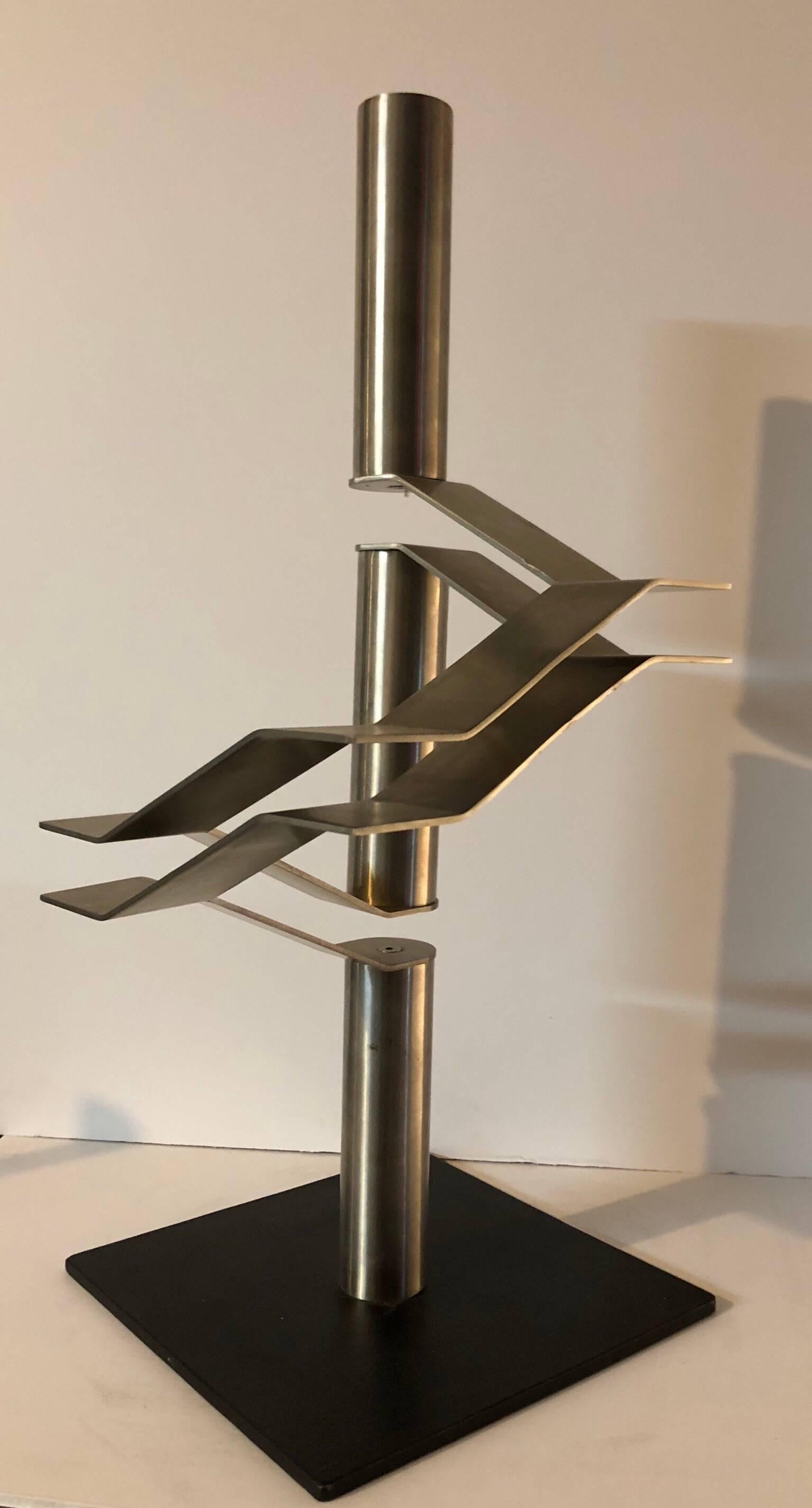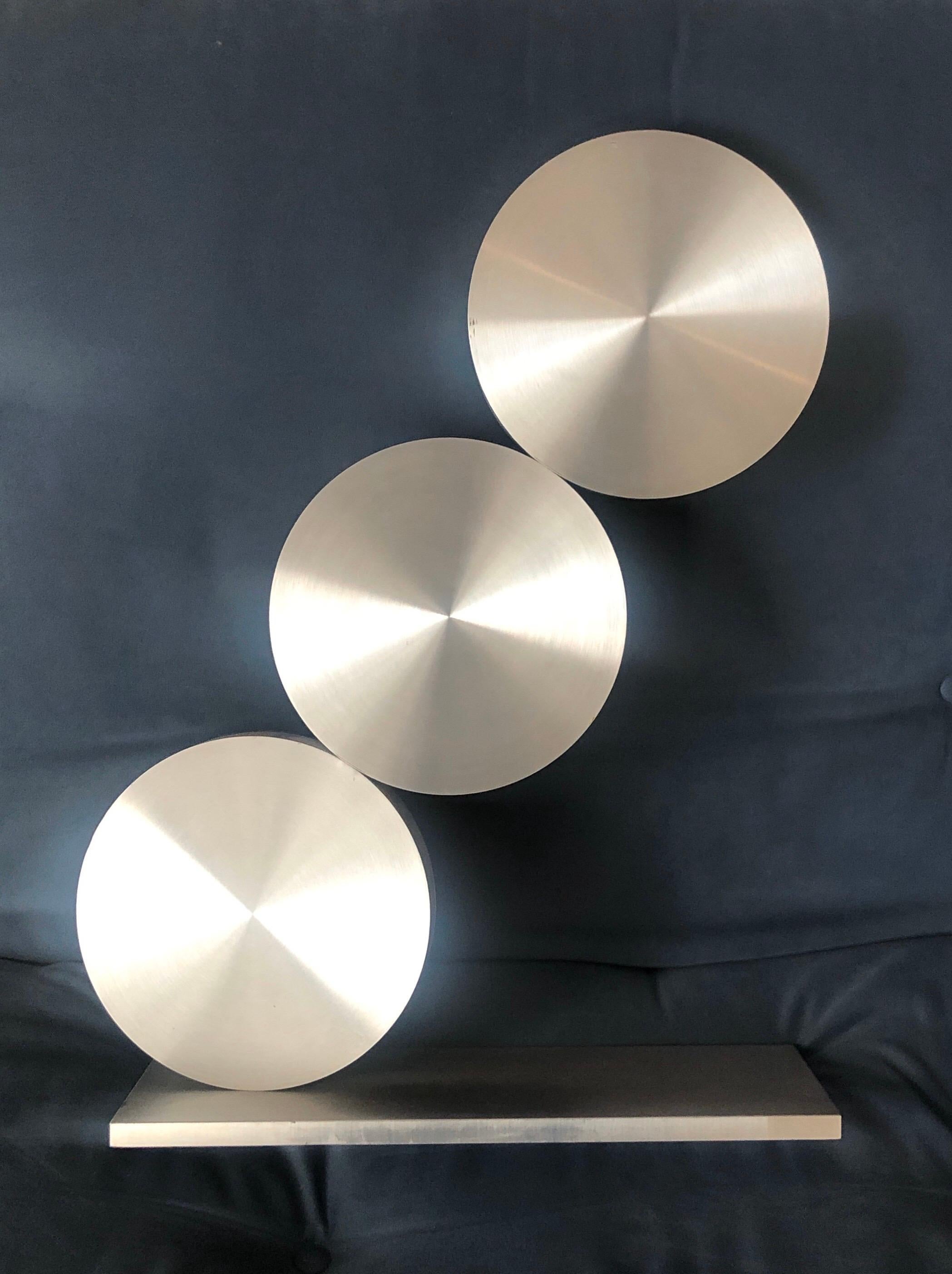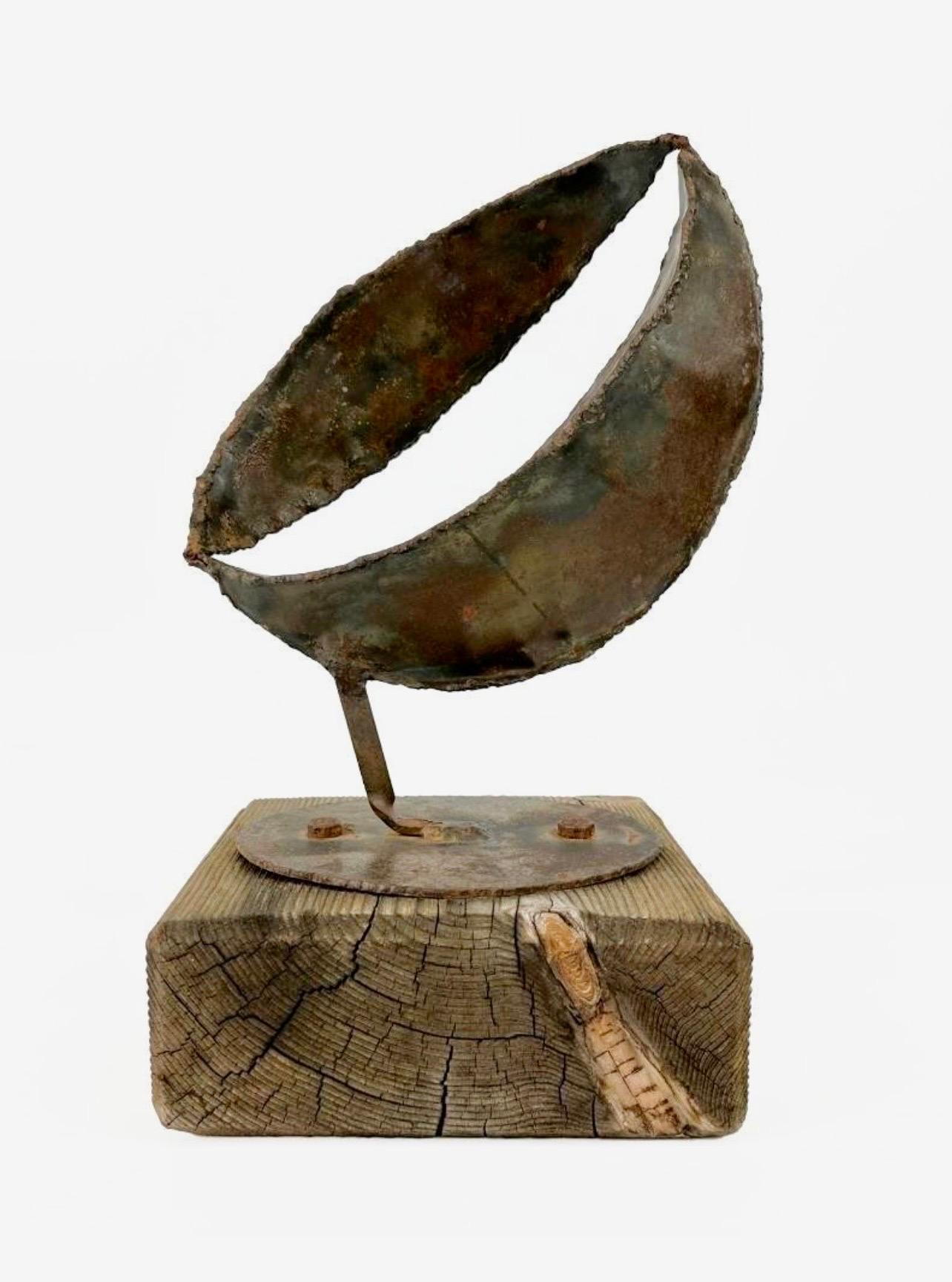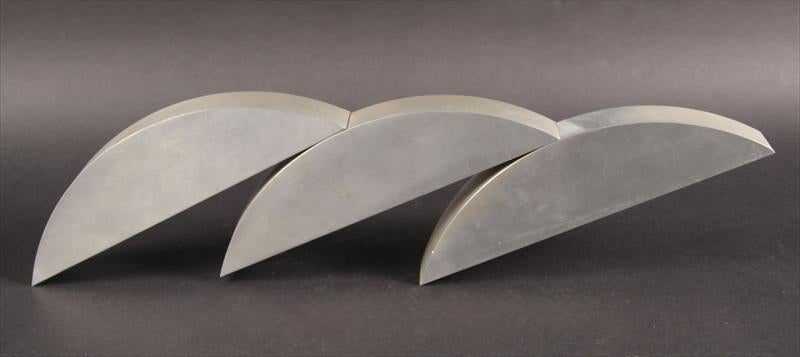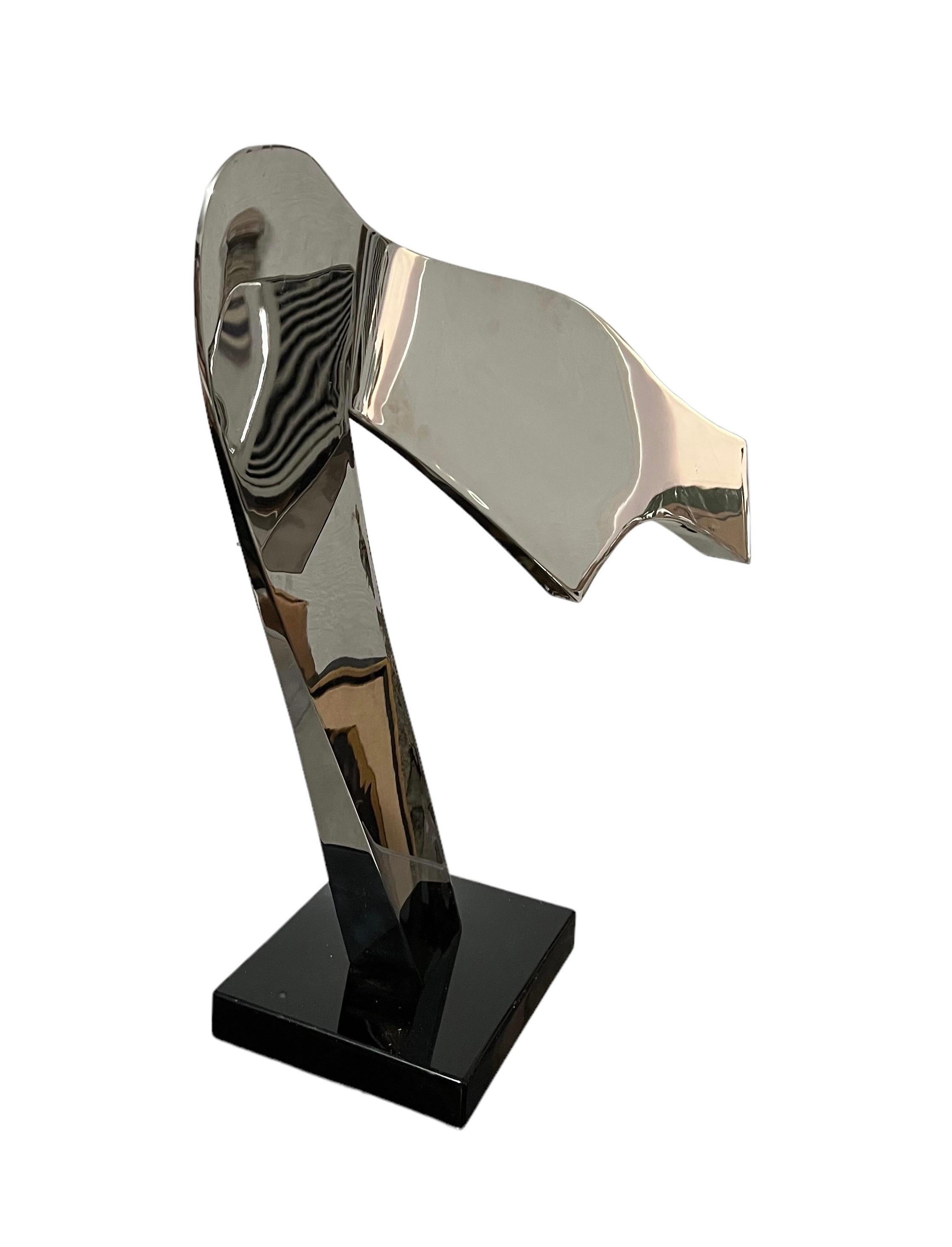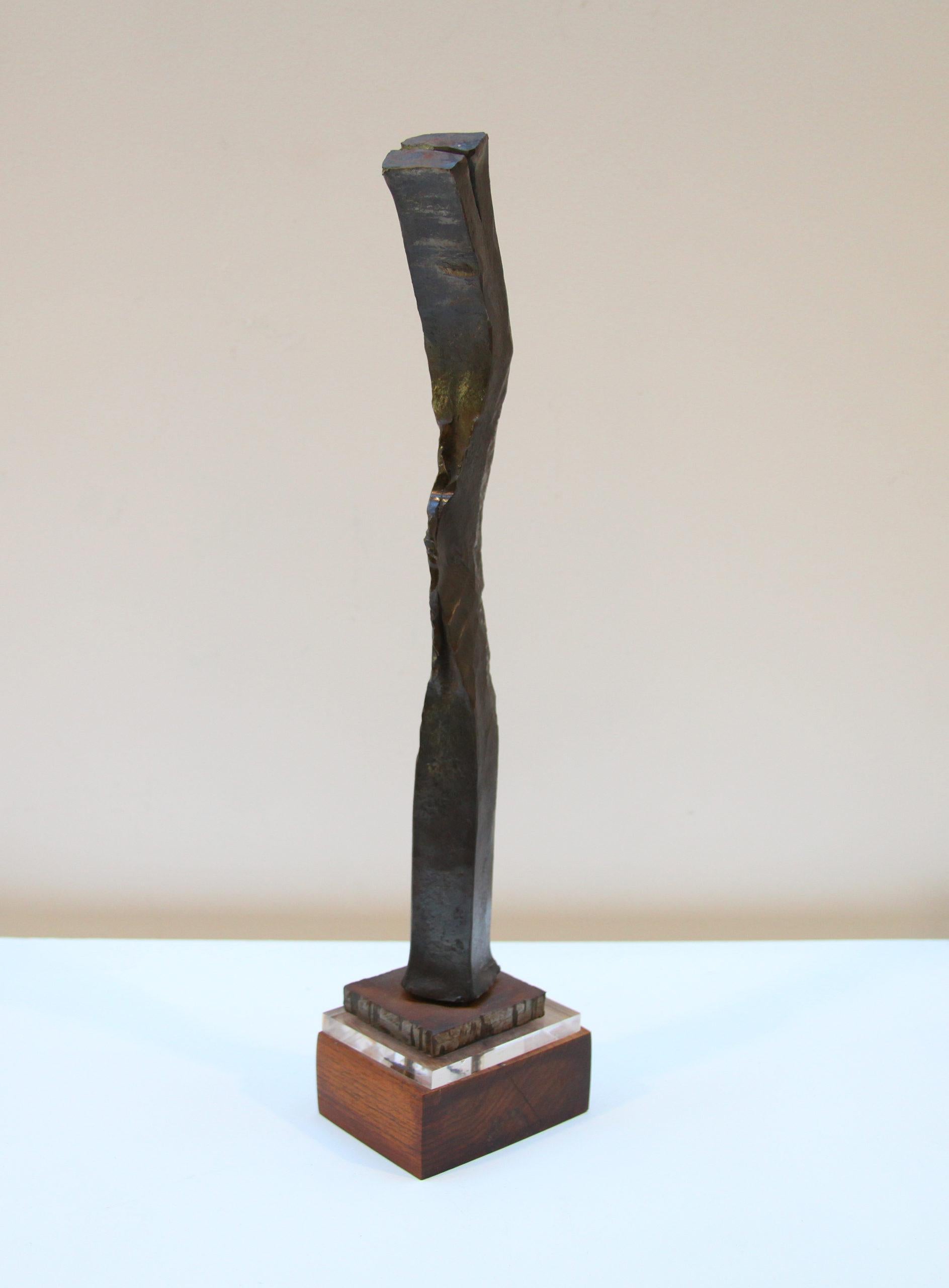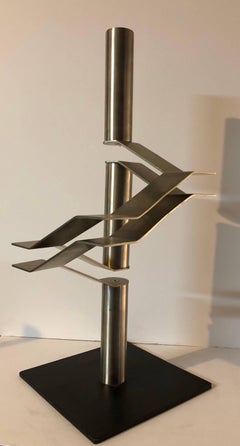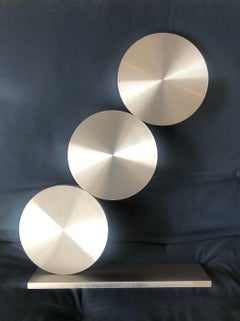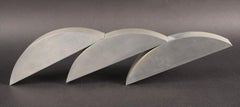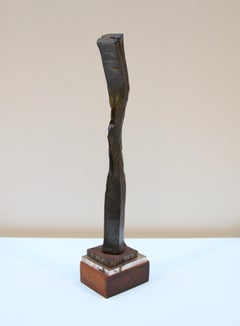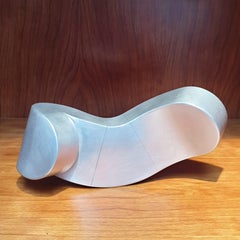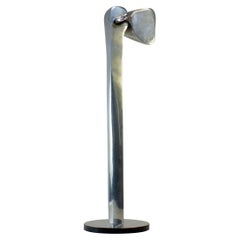Items Similar to Aharon Bezalel Israeli Modernist Sculpture 2 Parts Minimalist Aluminum or Steel
Want more images or videos?
Request additional images or videos from the seller
1 of 15
Aharon BezalelAharon Bezalel Israeli Modernist Sculpture 2 Parts Minimalist Aluminum or Steel1979
1979
$1,800
£1,366.78
€1,563.02
CA$2,514.86
A$2,797.07
CHF 1,460.55
MX$34,037.42
NOK 18,653.39
SEK 17,493.59
DKK 11,665.40
Shipping
Retrieving quote...The 1stDibs Promise:
Authenticity Guarantee,
Money-Back Guarantee,
24-Hour Cancellation
About the Item
A suite of 2 sculptures. Lovers, man and woman nestled together. sleek minimalist mod sculpture.
polished finish on one side. not sure if theese are stell or aluminium. they are cast and signed in Hebrew with initials and numbered 9/9. It is 2 parts that nest together.
Aharon Bezalel (born Afghanistan 1926) Born in Afghanistan in 1926 and immigrated to Israel at an early age. As a youth was engaged as a silversmith and craftsman, and was a student of the sculptor Zev Ben-Zvi from whom he absorbed the basic concepts of classic and modernist art and interpreted, according to them, ideas based on ancient Hebrew sources.
Aharon Bezalel works and resides in Jerusalem, he taught art for many years.
“I saw myself as part of this region. I wanted to find the contact between my art and my surroundings. Those were the first years of Jean Piro’s excavations at the Beer-Sheba mound. They found there, for example, the Canaanite figurines that I especially liked and that were an element that connected me with the past and with this place.” “…a seed and sperm or male and female. These continue life. The singular, the individual alone, cannot exist; I learned this from my father who dabbled with the Kabbalah.”
(Aharon Bezalel, excerpt from an interview with David Gerstein)
“The singular in Aharon Bezalel’s work is always potentially a couple if not a threesome, the one is also the many: when the individual is revealed within the group he will always seek a huddling, a clinging together.
The principle of modular construction is required by this perception of unity and multiplicity, as modular construction in his work is an act of conception or defense.
Two poles of unity, potentially alone, exist in Aaron Bezalel’s world: From a formal, sculptural sense these are the sphere and pillar, metaphorically these are the female in the final stages of pregnancy and the solitary male individual. Sphere-seed-woman; Pillar-strand-man. The disproportional, small heads in Aharon Bezalel’s figures leave humankind in it’s primal physical capacity. The woman as a pregnancy or hips, the man as an aggressive or defensive force, the elongated chest serves as a phallus and weapon simultaneously.
(Gideon Ofrat)
EIN HAROD About the Museum's Holdings: Israeli art is represented by the works of Reuven Rubin, Zaritzky, Nahum Gutman, Mordechai Ardon, Aharon Kahana, Arie Lubin, Yehiel Shemi, Yosl Bergner and others.
The graphic arts collection contains drawings and graphic works by Pissaro, Modigliani, Pascin, Chagall (almost all of his graphic work), and numerous other artists. The sculpture collection includes works by Jewish sculptors from all over the world including leading Israeli sculptors; Ben Zvi, Lishansky, David Palombo (brutalist), Yehiel Shemi, Aharon Bezalel and Igael Tumarkin (surrealist). Many Jewish sculptors from all parts of the world, beginning with Antokolski, are represented in the collection. In the sculpture courtyard there are works by Chana Orloff, Jacob Epstein (the works he bequeathed to the Museum), Glicenstein, Loutchansky, Constant and Indenbaum from Western Europe; Glid from Yugoslavia; Zorach, Gross and Harkavy from the United States; and most of the outstanding sculptors of Israel : Ben-Zvi, Lishansky, Ziffer, Lehmann, Feigin, Sternschuss, Palombo ( who executed the iron gate of the Museum), Aldouby, Yehiel Shemi, Aharon Bezalel, Hava Mehutan, Tumarkin.
- Creator:Aharon Bezalel (1925-2012, Afghan)
- Creation Year:1979
- Dimensions:Height: 25.5 in (64.77 cm)Width: 2.5 in (6.35 cm)Depth: 2 in (5.08 cm)
- Medium:
- Movement & Style:
- Period:
- Condition:fine patina, mild surface wear.
- Gallery Location:Surfside, FL
- Reference Number:Seller: 13991stDibs: LU38214281192
About the Seller
4.9
Platinum Seller
Premium sellers with a 4.7+ rating and 24-hour response times
Established in 1995
1stDibs seller since 2014
1,784 sales on 1stDibs
Typical response time: <1 hour
- ShippingRetrieving quote...Shipping from: Surfside, FL
- Return Policy
Authenticity Guarantee
In the unlikely event there’s an issue with an item’s authenticity, contact us within 1 year for a full refund. DetailsMoney-Back Guarantee
If your item is not as described, is damaged in transit, or does not arrive, contact us within 7 days for a full refund. Details24-Hour Cancellation
You have a 24-hour grace period in which to reconsider your purchase, with no questions asked.Vetted Professional Sellers
Our world-class sellers must adhere to strict standards for service and quality, maintaining the integrity of our listings.Price-Match Guarantee
If you find that a seller listed the same item for a lower price elsewhere, we’ll match it.Trusted Global Delivery
Our best-in-class carrier network provides specialized shipping options worldwide, including custom delivery.More From This Seller
View AllLarge Stainless Steel Abstract Israeli Sculpture 'Three Tubes' Maquette
By Israel Hadany
Located in Surfside, FL
Israel Hadany (Israeli, 1941-). A stainless steel maquette for sculpture "Three Tubes", currently installed at the University of Pennsylvania ...
Category
1970s Abstract Geometric Abstract Sculptures
Materials
Stainless Steel, Iron
Large 1970's Israeli Abstract Sculpture Steel Menashe Kadishman Tel Aviv Uprise
By Menashe Kadishman
Located in Surfside, FL
Hitromemut (Uprise)
Beautiful large sculpture by renowned Israeli sculptor Menashe Kadishman. Super quality, and visually stunning. There is a large monumental version of this in fro...
Category
1970s Abstract Geometric Abstract Sculptures
Materials
Stainless Steel
1965 Canadian Israeli Art Brutalist Abstract Welded Steel Sculpture Eli Ilan
Located in Surfside, FL
Eli Ilan (אלי אילן), 1928-1982 was an Israeli sculptor.
Abstract organic pod shape. in either steel or iron mounted on a wooden plinth.
Ilan was born in Winnipeg, Manitoba. He enrolled in a premedical curriculum at the University of British Columbia in Vancouver and emigrated to Israel in 1948. He then studied prehistoric archaeology and physical anthropology at the Hebrew University of Jerusalem. In 1956, he returned to Canada to study sculpture at the Ontario College of Art & Design. He lived in Kibbutz Sasa from 1959 to 1963. He died in 1982 in Caesarea, Israel.
Education
1955 Hebrew University, Jerusalem, pre-historic archaeology and physical anthropology
1956 Ontario College of Art, Toronto, Canada, sculpture under Thomas Bowie
1959 Training College, Ottawa, criminal identification techniques
1969 Art Festival, Painting & Sculpture in Israel. Ganei Hataarucha, Tel Aviv
Artists: Chana Orloff, Eli Ilan, Zvi Aldouby, Jacob El Hanani, Ludwig Blum, Aharon Bezalel, Koki Doktori, Israel Hadany, Marcel Janco, Dov Feigin, Abel Pann, Esther Peretz Arad, Reuven Rubin, Ivan Schwebel, Jakob Steinhardt, Boris Schatz, Bezalel (Lilik) Schatz, Louise Schatz...
Category
1960s Abstract Abstract Sculptures
Materials
Stainless Steel
60s Kadishman Israeli sculpture in steel or aluminum Suspension
By Menashe Kadishman
Located in Surfside, FL
Beautiful table top sculpture by renowned Israeli sculptor Menashe Kadishman. Super quality, and visually stunning. it is signed and numbered and dedicated Janet love george
Menashe Kadishman was born in Tel-Aviv in 1932. He is a Graduate of St. Martin's School of Art, University of London. From 1947 to 1950, Kadishman studied with the Israeli sculptor Moshe Sternschuss at the Avni Institute of Art and Design in Tel Aviv, and in 1954 with the Israeli sculptor Rudi Lehmann in Jerusalem. In 1959, he moved to London, where he remained until 1972. He had his first one-man show there in 1965 at the Grosvenor Gallery. His sculptures of the 1960s were Minimalist in style and so designed as to appear to defy gravity. This was achieved either through careful balance and construction, as in Suspense (1966), or by using glass and metal so that the metal appeared unsupported, as in Segments (1968). In 1995, he began painting portraits of sheep. These instantly-recognizable sheep portraits...
Category
1960s Modern Abstract Sculptures
Materials
Stainless Steel
Welded Stainless Steel Reflective Abstract Modernist Sculpture Gary Kahle
Located in Surfside, FL
Gary Kahle (American, 1942- )
Metal abstract sculpture on black base,
Hand signed and dated 1984
25 1/2" H x approximately 18" W x and 12 1/2" D.
Proven...
Category
1980s Abstract Abstract Sculptures
Materials
Stainless Steel
Israeli Contemporary Abstract Geometric Painted Pierced Sculpture Zigi Ben Haim
By Zigi Ben-Haim
Located in Surfside, FL
Zigi Ben-Haim,
Metal sculpture
Hand signed and dated Zigi Ben-Haim, 1998
Untitled, patinated aluminum or steel,
Dimensions: 6"h x 2"w x 2"d
This listing is for 1. I have 2 similar ones available.
Zigi Ben-Haim (born 1945 in Baghdad, Iraq) is an Iraqi-American-Israeli painter, collage artist and sculptor who lives and works in New York City and Israel.
Ben-Haim unveiled his sculpture, Treasure the Green, in SoHo on Broadway. The project was sponsored by the SoHo Broadway Initiative and the New York Department of Transportation's Art Program. The sculpture is considered to be the first sculpture to receive permission to be installed on a bus bulb on Broadway. The sculpture was made to "emphasize the importance of nature in our lives," and stands as a reminder of "the importance of reconnecting with the pure nature of the green." The sculpture uses the symbol of the leaf, which has been a major icon of Ben-Haim's work for the past 30 years. It symbolizes nature and it is a metaphoric way of emphasizing nature and the surrounding environment. He is of the first generation of Israeli artists to develop large international followings like Yaacov Agam, Menashe Kadishman and Avigdor Arikha.
Ben-Haim has received numerous grants and awards, including from Pollock-Krasner Foundation, National Endowments for the Arts, New York State Council on the Arts, The German Academic Exchange Service (DAAD), Emily Harvey Foundation Venice, Muestra Int. de Obra Grafica (Spain), and the Ministry of Culture in Israel. His works are included and exhibited in numerous public and private collections around the world, including the Guggenheim Museum in N.Y.C., the Jewish Museum, the Brooklyn Museum, the Israel Museum, and the Tel-Aviv Museum.
Education
1972-74 M.F.A., San Francisco State University, San Francisco, California, USA.
1972-73 M.A., J.F.K. University, Orinda, California, USA.
1971 California College of Arts & Crafts, Oakland, California, USA.
1966-70 The Avni Institute of Fine Arts, Tel Aviv, Israel.
Selected public collections
Splendid Step (2003) next to the Tel Aviv Museum of Art
Museum of Contemporary Art, Athens, Greece
Columbia Museum of Art, Columbia, SC
Israel Air Force Center Foundation, Tel Aviv, Israel
NASA, Houston, Texas
Bank Leumi USA, Fifth Avenue, New York, NY
Pfizer Company Collection, New York, NY
Reading Public Museum, Reading, PA
Guggenheim Museum, New York, NY
Haifa Museum, Haifa, Israel
Herbert F. Johnson Museum of Art, Cornell University, Ithaca, NY
New School, New York, NY
University of Maryland, College Park, Maryland.
Israel Museum, Jerusalem, Israel.
Brooklyn Museum, Brooklyn, NY
Malmö Museum, Malmö, Sweden.
Jewish Museum, New York, NY
Tel Aviv Museum of Art, Tel Aviv, Israel.
Museum of Fine Arts, Ghent, Ghent, Belgium.
National Gallery of Art, Washington D.C.
Fine Arts Museum of Long Island, Hempstead, NY
Buscaglia-Castellano, University Museum, Lewiston, NY
Dan Eilat Hotel, Israel.
International Paper Company, New York, NY
World Bank, Washington D.C.
Westminster Bank, New York, NY
Israel Embassy, Washington D.C.
Frederick R. Weisman, Los Angeles, CA.
Rikers Hill Sculpture Park, Livingston, NJ
Heckscher Museum of Art, Huntington, NY
Allen Memorial Art Museum, Oberlin College, Oberlin, Ohio
Group Exhibitions
Bertha Urdang Gallery, NY, USA
Artists: Larry Abramson, Yosef Zaritsky, Zelig Segal...
Category
1980s Abstract Geometric Abstract Paintings
Materials
Metal
You May Also Like
An Abstract Steel Metal Sculpture, "Untitled Steel Sculpture"
Located in San Diego, CA
A one of a kind 3" x 18" x 4" Abstract Steel Metal Sculpture executed by artist James Hubbell. A certificate of authenticity will be provided upon its purchase.
James Hubbell is an...
Category
2010s Abstract Abstract Sculptures
Materials
Steel
Goodbye - aluminum contemporary modern abstract geometric sculpture
By Henk van Putten
Located in Doetinchem, NL
Goodbye (work no. HVP01142) is a small size contemporary modern abstract geometric aluminum sculpture by acclaimed Dutch constructivist Henk van Putten, who was born in The Netherlan...
Category
1990s Constructivist Abstract Sculptures
Materials
Metal
1978 Italy Stainless Steel Abstract Sculpture by Carmelo Cappello
By Carmelo Cappello
Located in Brescia, IT
This is an artwork created by the well known Italian artist Carmelo Cappello. It is a multiple, an Abstract Sculpture one of the identical 99 specimen edited in 1978. This piece is ...
Category
1970s Abstract Geometric Abstract Sculptures
Materials
Stainless Steel
1970 Giacomo Benevelli Modernist Cast Steel Inox Sculpture
By Giacomo Benevelli
Located in Brescia, IT
Giacomo Benevelli
1973
Cast Steel Inox Sculpture
Very Good Condiction
Category
Vintage 1970s Italian Modern Abstract Sculptures
Materials
Steel
Pareja 07 - contemporary modern abstract geometric steel sculpture
By Eduardo Lacoma
Located in Doetinchem, NL
Pareja 07 is a unique contemporary modern abstract sculpture by Spanish artist Eduardo Lacoma from his latest series Pareja, Spanish for couple. The sculpture consists of two handmade constructions from cut, welded and polished steel, that are mounted together to form a true complementary couple. The outer element is 5 mm carbon steel which has been varnished, the inner element is 5 mm corten steel which has been oxidized. Due to the manual process of building and finishing, each element has its own characteristic look, sometimes very smooth, sometimes a little rough but always very sophisticated. From all sides it offers intriguing views, now more closed, then more open. It fits perfectly in a contemporary modern interior setting, on a side table, on a shelf or even on a plinth. It evokes feelings of mid-century modern design whilst being a one-of-a-kind 21st century piece.
Eduardo Lacoma (1968, Spain) is a practicing sculptor since many years, in addition to his career as an electronics technician. Being profoundly inspired by art during a trip to Barcelona in his teens, he taught himself the fine art of sculpting, combining materials such as iron, steel and stone. Living and working in Pamplona in the Basque region of Spain, he was originally inspired by the architecture of Gaudi. Gradually his interest shifted however to the sculptural forms of Eduardo Chillida and Jorge Oteiza...
Category
2010s Contemporary Abstract Sculptures
Materials
Steel
Pareja 03 - contemporary modern abstract geometric steel sculpture
By Eduardo Lacoma
Located in Doetinchem, NL
Pareja 03 is a unique contemporary modern abstract sculpture by Spanish artist Eduardo Lacoma from his latest series Pareja, Spanish for couple. The sculpture consists of two handmad...
Category
2010s Contemporary Abstract Sculptures
Materials
Steel
More Ways To Browse
Minimalist Metal Sculptures
Minimalist Steel Sculptures
Polished Aluminum Sculpture
Modular Sculpture
Head Male Sculpture
Metal Pillar
Nest Sculpture
Metal Sphere Sculpture
Male Metal Sculpture
Used Steel Gates
Cast Iron Chest
Brutalist Man Sculpture
Brutalist Sculpture Woman
Brutalist Israel
Small Metal Figurine
Vintage Craftsman Chest
Vintage Craftsman Saws
Vintage Couple Figurines
